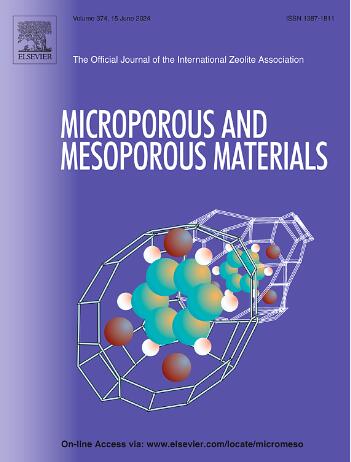Strategies for the preparation of MOFs-based composites and their research progress in electrocatalysis
IF 4.8
3区 材料科学
Q1 CHEMISTRY, APPLIED
引用次数: 0
Abstract
This review systematically explores the application and research progress of metal-organic frameworks (MOFs) based composites in electrocatalysis. Firstly, we introduce a variety of preparation methods for MOFs-based composites, including in situ doping/substitution, hydrothermal/solvent-thermal methods, solution impregnation, dual-solvent impregnation, and sandwich assembly, with a focus on analyzing the effects of different methods on the structure and properties of the materials. Secondly, the practical applications of MOFs-based composites in electrocatalytic reactions, including hydrogen evolution reaction, oxygen evolution reaction, oxygen reduction reaction, nitrogen reduction reaction, and carbon dioxide reduction, are elaborated in detail, with emphasis on their excellent properties and catalytic mechanisms. Finally, we look forward to the future development trend of MOFs-based composites, and believe that with the emergence of novel synthesis technologies and idealized design methods, MOFs-based composites will show greater potential for applications in areas such as renewable energy conversion and environmental governance. In summary, this review provides a comprehensive perspective and in-depth analysis of the electrocatalytic studies of MOFs-based composites.

mofs基复合材料的制备策略及其电催化研究进展
本文系统地综述了金属有机骨架复合材料在电催化中的应用及研究进展。首先,我们介绍了mofs基复合材料的各种制备方法,包括原位掺杂/取代法、水热/溶剂热法、溶液浸渍法、双溶剂浸渍法和三明治组装法,重点分析了不同方法对材料结构和性能的影响。其次,详细阐述了mofs基复合材料在析氢反应、析氧反应、氧还原反应、氮还原反应和二氧化碳还原等电催化反应中的实际应用,重点介绍了mofs基复合材料的优异性能和催化机理。最后,展望了mofs基复合材料的未来发展趋势,相信随着新型合成技术和理想化设计方法的出现,mofs基复合材料将在可再生能源转化和环境治理等领域显示出更大的应用潜力。综上所述,本文对mofs基复合材料的电催化研究进行了全面和深入的分析。
本文章由计算机程序翻译,如有差异,请以英文原文为准。
求助全文
约1分钟内获得全文
求助全文
来源期刊

Microporous and Mesoporous Materials
化学-材料科学:综合
CiteScore
10.70
自引率
5.80%
发文量
649
审稿时长
26 days
期刊介绍:
Microporous and Mesoporous Materials covers novel and significant aspects of porous solids classified as either microporous (pore size up to 2 nm) or mesoporous (pore size 2 to 50 nm). The porosity should have a specific impact on the material properties or application. Typical examples are zeolites and zeolite-like materials, pillared materials, clathrasils and clathrates, carbon molecular sieves, ordered mesoporous materials, organic/inorganic porous hybrid materials, or porous metal oxides. Both natural and synthetic porous materials are within the scope of the journal.
Topics which are particularly of interest include:
All aspects of natural microporous and mesoporous solids
The synthesis of crystalline or amorphous porous materials
The physico-chemical characterization of microporous and mesoporous solids, especially spectroscopic and microscopic
The modification of microporous and mesoporous solids, for example by ion exchange or solid-state reactions
All topics related to diffusion of mobile species in the pores of microporous and mesoporous materials
Adsorption (and other separation techniques) using microporous or mesoporous adsorbents
Catalysis by microporous and mesoporous materials
Host/guest interactions
Theoretical chemistry and modelling of host/guest interactions
All topics related to the application of microporous and mesoporous materials in industrial catalysis, separation technology, environmental protection, electrochemistry, membranes, sensors, optical devices, etc.
 求助内容:
求助内容: 应助结果提醒方式:
应助结果提醒方式:


